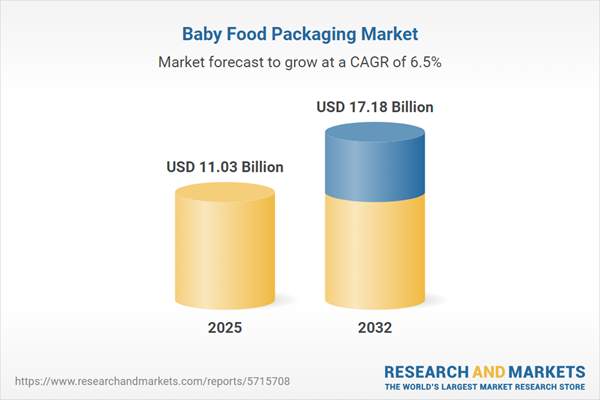Speak directly to the analyst to clarify any post sales queries you may have.
Senior executives seeking actionable insights into the competitive landscape of the baby food packaging market will find this report essential for understanding the evolving roles of health, safety, sustainability, and convenience in shaping packaging strategies worldwide. Designed to inform strategic planning, the analysis highlights critical growth drivers, emerging technology, and adaptive responses to regulatory pressures affecting procurement and supply chains.
Market Snapshot: Baby Food Packaging Market Size and Growth Trends
The baby food packaging market grew from USD 10.35 billion in 2024 to USD 11.03 billion in 2025. This market is projected to expand at a CAGR of 6.53%, reaching USD 17.18 billion by 2032. Substantial growth is being driven by convergence of consumer demand for safe, sustainable, and convenient packaging solutions, supported by advances in material science and regulatory adaptation.
Scope & Segmentation of the Baby Food Packaging Market
This report assesses global and regional market dynamics, offering detailed segmentation for precise decision-making:
- Packaging Material: Glass, metal, and plastic—each offering unique advantages in recyclability, inertness, and packaging flexibility.
- Packaging Format: Bottle, jar, pouch, sachet, stick pack, and tray, each format tailored to various distribution channels and consumer use cases.
- Closure Type: Heat seal, peel seal, screw cap, and snap lid, addressing demands for safety, resealability, and user-friendly handling.
- Category: Multi serve and single serve options, meeting needs for portion control, on-the-go convenience, and waste reduction.
- Regions Analyzed: Americas (including United States, Canada, Mexico, Brazil, Argentina, Chile, Colombia, Peru); Europe, Middle East & Africa (United Kingdom, Germany, France, Russia, Italy, Spain, Netherlands, Sweden, Poland, Switzerland, UAE, Saudi Arabia, Qatar, Turkey, Israel, South Africa, Nigeria, Egypt, Kenya); and Asia-Pacific (China, India, Japan, Australia, South Korea, Indonesia, Thailand, Malaysia, Singapore, Taiwan).
- Key Company Coverage: Tetra Pak International SA, Amcor plc, Berry Global, Inc., Huhtamaki Oyj, Sealed Air Corporation, Owens-Illinois, Inc., Gerresheimer AG, Crown Holdings, Inc., Silgan Holdings Inc., and AptarGroup, Inc.
Key Takeaways for Senior Decision-Makers
- Innovations in material engineering and packaging design are being prioritized to balance safety, durability, and environmental objectives. Manufacturers align closely with packaging specialists to co-develop consumer-centric solutions.
- Consumer expectations are raising the bar for recyclable and reusable packaging formats, pushing the adoption of circular economy principles across product lines.
- The growth in e-commerce and digital retail channels is accelerating demand for flexible, protective, and lightweight packaging offerings, influencing shipping and logistics strategies.
- Strategic partnerships between brand owners and packaging firms are fostering advances in barrier technologies, customized labeling, and smart packaging features for enhanced product monitoring and marketing agility.
- Regional markets exhibit distinct adoption curves: The Americas prioritize sustainability; Europe, Middle East & Africa focus on compliance and advanced materials; Asia-Pacific capitalizes on urbanization and rising disposable income.
Tariff Impact: Policy Shifts Shaping Supply Chain and Sourcing
The implementation of new United States tariffs in 2025 introduces a complex layer of cost variability in the baby food packaging supply chain. Elevated duties on aluminum closures, plastic resins, and films are leading companies to pursue alternative sourcing, nearshoring, and diversified suppliers. The need to reduce exposure to fluctuating import costs is accelerating the adoption of lightweighting initiatives and design simplification. Industry leaders should revisit contract and pricing models and enhance advocacy efforts with trade associations to help ensure supply continuity and competitive positioning in a shifting regulatory environment.
Methodology & Data Sources
This report utilizes a dual research methodology combining comprehensive secondary analysis with targeted primary research. Industry data were validated through literature review, patent analysis, and in-depth interviews with market executives, engineers, and brand managers. Surveys and scenario modeling ensure actionable, reliable insights supporting executive-level decision making.
Why This Report Matters
- Equips executives and procurement leaders to anticipate shifting market dynamics, optimize sourcing, and address evolving consumer and regulatory requirements.
- Provides detailed segmentation, enabling product teams to tailor packaging strategies and investments to high-growth regions and emerging consumer trends.
- Delivers practical insights for operational resilience and strategic sourcing, helping organizations fortify profitability against tariff and materials inflation risks.
Conclusion
Adaptive and sustainable packaging strategies are increasingly critical in the baby food sector. Thorough segmentation and analysis enable leadership teams to craft proactive responses and competitive differentiation. A holistic, informed approach positions companies for long-term success as safety, sustainability, and convenience continue to drive market transformation.
Additional Product Information:
- Purchase of this report includes 1 year online access with quarterly updates.
- This report can be updated on request. Please contact our Customer Experience team using the Ask a Question widget on our website.
Table of Contents
3. Executive Summary
4. Market Overview
7. Cumulative Impact of Artificial Intelligence 2025
Companies Mentioned
The companies profiled in this Baby Food Packaging market report include:- Tetra Pak International SA
- Amcor plc
- Berry Global, Inc.
- Huhtamaki Oyj
- Sealed Air Corporation
- Owens-Illinois, Inc.
- Gerresheimer AG
- Crown Holdings, Inc.
- Silgan Holdings Inc.
- AptarGroup, Inc.
Table Information
| Report Attribute | Details |
|---|---|
| No. of Pages | 194 |
| Published | October 2025 |
| Forecast Period | 2025 - 2032 |
| Estimated Market Value ( USD | $ 11.03 Billion |
| Forecasted Market Value ( USD | $ 17.18 Billion |
| Compound Annual Growth Rate | 6.5% |
| Regions Covered | Global |
| No. of Companies Mentioned | 11 |









